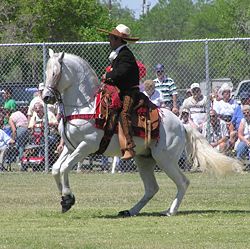.gif)
Pirouette (dressage)
Encyclopedia

A pirouette is a two-track lateral movement
Lateral movement
Lateral movements or lateral flexions within equestrianism, have a specific meaning, used to refer to movements made by a horse where the animal is moving in a direction other than straight forward...
asked of a horse in dressage
Dressage
Dressage is a competitive equestrian sport, defined by the International Equestrian Federation as "the highest expression of horse training." Competitions are held at all levels from amateur to the World Equestrian Games...
, in which the animal makes a circle with its front end around a smaller circle made by the hind end. Specifically, the front legs and outside hind leg should travel around the inside hind leg, with the horse remaining slightly bent in the direction of travel. From the part of the rider it needs "much practice in collecting
Collection (horse)
Collection is when a horse carries more weight on his hindlegs than his front legs. The horse draws the body in upon itself so that it becomes like a giant spring whose stored energy can be reclaimed for fighting or running from a predator...
and balancing the horse and in using the aids correctly."
The horse may perform the movement at the walk or canter
Canter
The canter is a controlled, three-beat gait performed by a horse. It is a natural gait possessed by all horses, faster than most horses' trot but slower than the gallop, and is used by all riders. The speed of the canter varies between 16-27 km/h , depending on the length of the stride of the horse...
, although the pirouette at the walk is more commonly called the turn on the haunches
Turn on the haunches
The turn of the haunches is a lateral movement performed at the halt and walk, used in horse training. It requires the horse, while bent in the direction of the turn, to move his forehand around his hindquarters so that he makes a very small circle with the inside foreleg. The horse should not...
. It "can also be executed at piaffe
Piaffe
The piaffe[p] is a dressage movement where the horse is in a highly collected and cadenced trot, in place or nearly in place. The center of gravity of the horse should be more towards the hind end, with the hindquarters slightly lowered and great bending of the joints in the hind legs...
."
As in all dressage, the horse should remain relaxed, engaged, and responsive, with the poll
Poll (horse)
The poll is a name of the part of an animal's head, alternatively referencing a point immediately behind or right between the ears. This area of the anatomy is of particular significance for the horse....
as the highest point. Ideally, the pirouette will be almost in-place, although many horses perform a slightly larger pirouette. A pirouette may be performed either as a 360-degree turn (full pirouette), 270 degrees (¾-pirouette), or 180-degrees (half-pirouette). Some dressage tests call for two full pirouettes in a row (720 degrees).
Number of beats and strides
The walk stride has to consist of four beats. Pivoting around one hindleg without lifting it is not considered a correct movement: "The inside hind foot is raised and put down almost in the same place".When performed at the canter, the gait actually is meant to remain a three-beat action with a moment of suspension. However, the high level of collection, strength and discipline required means that it often degenerates into an incorrect four-beat motion. The correct half-pirouette in canter "should take three steps" or strides, the whole pirouette should take "five to seven" strides.
Faults
The canter pirouette is a very difficult exercise when performed correctly.- The horse should not throw his body around, fall inward, or let his hindquarters fall to the outside, but should remain balanced.
- The horse should not plant one of his hind legs and move around it—as seen in the western spin—but should lift them up and place them down with each stride, maintaining the purity of the gait.
- The horse should not lose the rhythm of the canter, or fall onto his forehandForehand (horse)- Balance :A horse's "motor" is located in his hindquarters, and a horse that is heavy on the forehand is not able to properly move forward with impulsion...
. - The horse should not make an oval-shaped movement with his hindquarters, but should inscribe a perfect circle.
- The horse should never step back.
- Each bound should be equal.
- It must not degenerate into a four-beat motion or lose its moment of suspension.

